Theme Parks & Themed Entertainment
A JHM Exclusive: Your first look at Universal Orlando’s “Revenge of the Mummy” thrill ride
JHM columnist Seth Kubersky returns with a detailed description of this brand new yet-to-be-officially-opened indoor roller coaster.

WARNING!
The following contains spoilers. The following is based on an incomplete attraction, and should not be construed as representative of the final product. The ride is in private technical rehearsals, and is not open to the public. Do not go to the park expecting to experience the ride until the official opening date. Your mileage may vary. Discontinue use if rash develops.
Riding a new ride during “technical rehearsals” is always a dicey proposition. It’s called a rehearsal for a good reason, since major element are often incomplete, and the fine-tuning that separates a good ride from a great one is absent. Over the years, I’ve had the privilege of experiencing some of Orlando’s biggest attractions weeks or even months before the general public, and it hasn’t always been as fun as you’d imagine.
Sometimes it’s an exercise in frustration; my first visit to IOA’s “Spiderman” involved three hours in the queue, climaxing in the building being evacuated when I was a dozen people from the car. Sometimes it’s terribly disillusioning; after my first trip through Animal Kingdom’s “Countdown to Extinction,” I had to ask the attendants when they were installing the dinos (sadly, it never improved much). Occasionally, the first preview is the best experience you’ll ever have on a ride; I’ll never forget how wonderfully nauseating the “Cat in the Hat”‘s spinning cars were at first.
And sometimes, a technical preview can be like a glimpse of future greatness. Like watching the “work-in-progress” version of “Beauty and the Beast.” Yes, the lines are rough, and many of the colors missing. There may even be a mild hiccup in the story (they sing “Be Our Guest” to Belle’s father?). But it’s clear that you are experiencing something magical. You know that you are watching artists at the top of their form, taking everything they’ve learned in the past to create something you and your kids will want to experience over and over. And you know that, given a little more time and polish, it just might change the world.
That’s what Universal Orlando’s “Revenge of the Mummy” is like right now. The rough draft of a masterpiece. And I have every confidence that before the first paying guest steps on it, Universal will make sure it lives up to it’s already-obvious potential.
For anyone who’s been hiding in a theme-park-news-free bunker, “Revenge of the Mummy” (ROTM) is Universal Studios Florida’s new headliner attraction, slated to open later this Spring. A sister attraction is also opening at Universal Studios Hollywood. Both are based on Universal’s “Mummy” franchise, starring Brendan Fraser and directed by Stephen Sommers. They may have the distinction of being the first theme park attractions to be significantly better than the movies they are based on. Ok, maybe second after “Waterworld”.
The Florida version is housed in the building formerly occupied by the much-beloved “Kongfrontation.” Fans of the late great ape, rest assured. Not only does ROTM not desecrate that hallowed ground, it is a more than worthy successor to old banana breath. And, rumor is, you might catch a glimpse of old monkey if you keep your eyes peeled.
Costing a reported $45 million (small change compared to recent E-tickets like “Mission: Space”), ROTM does not radically break new ground in the same way that “Spiderman” did. The basic elements, an indoor roller-coaster with magnetically launched trains, has been seen before. The special effects — ranging from air and water blasts, to flames, to video projections and sophisticated animatronics — are evolutionary rather than revolutionary. But no ride has combined so many of these effects, in such complex synchronization, at such a blistering pace. Universal touts this as a “psychological thrill ride” with good reason. The dominant effect is total sensory overload, an unparalleled avalanche of astounding sights and sensations that will leave you reeling. You’ll exit the ride knowing you missed half of what’s in there, and not believing half of what you actually saw.
The experience starts before you even enter the queue, proving once again that Universal understands how important the entire package is, beyond just the ride itself. Attraction cast members performed a brief “streetmosphere”-style interaction with the waiting crowd, picking out “extras” for a “screen test”, reminiscent of the “Earthquake” preshow. Other employees scurried about with trays of coffee for the “stars”, a gag that carries through the entire attraction. I don’t know if this was solely for the benefit of the employee preview, but I hope it continues, and survives the pressures of the enormous crowds this ride will attract this summer. Bravo to the cast members, who went all out despite being attractions personnel and not actors.
You enter the attraction not through the museum façade, as with Kong, but through the Paradise Theater. This is an epic queue line in classic Universal style, and fitting replacement for Kong’s legendary queue. The initial sections, inside the building that once held the Islands of Adventure preview center, feature props and design sketches from the first two Mummy films.
Overhead video monitors present a Christopher Guest-style mockumentary about the filming of a new Mummy movie. We are introduced to “Reggie”, a bumbling production assistant, and are informed of strange happenings on the set. They also make mention of a mystical symbol that is needed to protect us against the evil Imhotep’s curse.
Unfortunately, the high ceilings, hard surfaces, and chattering guests conspire to make the preshow video almost completely unintelligible. This is a shame, since it sets up story elements that are important to the full enjoyment of the ride. As a sound engineer, I can sympathize with the designers, and I trust they’ll find a way to overcome the lousy acoustics.
After passing through a black, empty room (I assume there is work to be done here), you enter the attraction proper through the old Kong entrance. There are some cages full of props and costumes, and more video monitors. You turn a corner, and suddenly you are inside an exquisitely detailed Egyptian tomb. I was unsure at this point whether we were meant to be on the set of the new film, or if we were “transported” to an actual tomb by Imhotep’s curse. Perhaps the confusion is intentional. It’s a moot point because this section features some of the best scenic design ever seen in a queue. Though not nearly as long, it is every bit as well crafted as the queue for IOA’s “Dueling Dragons,” which is high praise indeed.
Best of all, there are a number of interactive elements to entertain you. A sarcophagus with a handprint engraved on it causes the lights to flicker when touched. A glowing jewel activates air blasts further down the queue, and an adjacent video monitor shows the humorous results (though wouldn’t it make sense for the air blasts to come first?). And, my favorite, a hologram of golden treasure blasts with air anyone foolish enough to reach for it. It’s unclear how much of the queue those using the Express Pass and Single Rider lines will experience, but this queue is well worth waiting in.
Soon, you enter a tall chamber dominated by a huge statue of Anubis. Wooden stairs spiraling up lead you to the loading platform. There is an elevator for those with disabilities, everyone else gets some exercise. At the top, there are twin loading platforms, to your left and right, each accommodating one car. The vehicles, styled like mine cars, feature four rows of four passengers each. The rear rows are slightly elevated, giving a good view to all. The lap bars are unusually tall, reaching from your waist up to your sternum, but comfortable. The headrests are tall but do not wrap around the side of your head.
And away we go! I won’t give a detailed blow-by-blow of the ride. If you want every moment spoiled for you, you can find it elsewhere online. Moreover, I couldn’t give an accurate accounting after one trip through the ride due to the sheer volume of stuff thrown at you. The first time through, even in an unfinished state, is so overwhelming that detached analysis is simply impossible. I will give an outline of the experience, and describe some of the highlights.
WARNING: STOP NOW TO AVOID MAJOR SPOILERS!
Still there? Ok…
We enter a tomb, with mummified corpses strewn about. From the first moment you can tell that great detail has been put into creating a complete 360º environment, with lighting and music to match. A voice (the “Reggie” animatronic is yet to arrive) warns us of Imhotep’s curse. Around the corner, Reggie is turned into a Mummy by Imhotep (another work-in-progress). You are sent into the next room, which is where things start to get really interesting.
An enormous projection of Imhotep offers you riches for your soul, and piles of treasure are illuminated to either side of you. If you refuse, he warns, you’ll die. Mummy warriors appear next to you, lunging at the car (they do not, however, jump on the car). Flames explode around you, and for an extra shock you are sprayed with water. You take a quick turn into a new room, which seems to be a dead end. The wall in front of you suddenly sprouts thousands of scarab beetles, which swarm towards your vehicle. I assume that this projection will eventually be accompanied by a tactile effect, similar to “It’s Tough to Be a Bug,” but for now there is only light and sound.
You are quickly launched backwards down a short hill, and then quickly come to a stop in a rotating room. There is some more threatening from Imhotep, as you are turned to face an enormous hill. At the top of the hill looms Imhotep’s giant head. You are launched up the hill, straight into his gaping mouth.
What follows is the coaster portion of the ride, a giddying minute or so of dips and turns. There are no inversions, and the actual scare-factor lies somewhere between “Woody Woodpecker’s Nuthouse Coaster” and “Space Mountain.” It does have the advantage of being an exceptionally smooth and comfortable ride, with well-engineered turns and a pleasant amount of airtime. Heightening the effect are numerous illuminated apparitions, flickering to ghostly life seeming inches from your head. They may be simple back-lit cutouts, but they are extremely effective, much more so than the tacky black light props in “Rock ‘n Roller Coaster.” Add in the music and sound effects, and this section is far more thrilling that you might imagine the fairly tame drops and banks would be. Don’t let the idea of a roller coaster scare you away from this ride – it’s much more likely to make you laugh with delight than scream in terror.
Before you know it, you are out of the coaster section and at what appears to be the unload station. To your left, you see the silhouette of a ride attendant inside her booth. I believe another animatronic attendant is yet to be installed. You come to a stop, and they thank you for riding the ride, but Imhotep arrives and vaporizes the attendants in mid-spiel. The ceiling above you ignites in a beautiful “brain-fire” effect that will be familiar to those who have ridden Busch Garden’s Escape From Pompeii. You are launched in the final brief coaster section of the ride, similar to the first.
And then… well, I’m not sure. A ride this spectacular deserves an appropriate finale, and I’m sure that by the time it opens, this one will have one. For now, I’m not really sure what I saw. I assumed I’d see some representation of Imhotep being defeated, presumably involving the symbol that was mentioned in the preshow. I don’t think I saw that. There were lights, and noise, and frankly I was a bit dazed, but I don’t think I saw a resolution to the story.
The next thing I knew, Brendan Frasier was congratulating me from a video screen, and demanding a cup of coffee. There is a goofy sight gag that again calls into question the frame of reference for the story – what is the “reality” of this attraction? And then we were on a fairly sparse unload platform, and down the old exit ramp past the cashiers that sit where the Kong photo op used to be.
END OF SPOILERS. YOU CAN START READING AGAIN NOW!
Obviously, the ride still has a ways to go, which is why the public soft-opening is still expected to be several weeks away. Some of the missing effects are crucial to the story, which as any good theme park designer knows it the most important part of an attraction. The finale in particular needs more of a sense of closure. I also had trouble understanding much of the dialogue in the ride, a problem I don’t have on any other attractions. Part of this is psychological, as there is just too much happening at once to absorb it all. There is also speaker tuning that needs to be done during this test-and-adjust phase.
But even in this incomplete state, you can tell ROTM is destined for greatness. The only criticism I can levy is also the biggest compliment – it’s too short. Not in terms of time, as its 3½ minute ride time is about average. And not in terms of physical size, since it occupies one of the largest ride buildings in the world, and features sets that are epic in scope. No, you want it to be longer because there is just so much to see and experience that you wish it could just go on and on. A great showman always leaves ’em wanting more, and this ride does that in spades.
This ride will raise your expectations of what a ride can be. You may feel a little let down when you realize that eventually, it ends and you have to get off. At the moment, this feeling is intensified by the fact that the ending doesn’t generate the kind of catharsis that “Spiderman”‘s high fall or “Indiana Jones”‘s rolling boulder does. I have faith that will change, and ROTM will take its place alongside the great theme park attractions of the world.
Universal has proved once again that they are the masters of postmodern theme park design. They didn’t invent anything you’ve never seen before. They’ve taken everything you’ve seen in the past, and put it all together in a way that you’ve never imagined. My philosophical musings on the ambiguous setting of the attraction is a plus, as it indicates the kind of complexity that makes for re-rideability.
Bob Gault, Scott Trowbridge, Stephen Sommers, and everyone else involved should feel very proud of the work they’ve done. Good luck to the opening crew, and save me a seat (back row, left corner) when everything is 100%!
Television & Shows
The Untold Story of Super Soap Weekend at Disney-MGM Studios: How Daytime TV Took Over the Parks
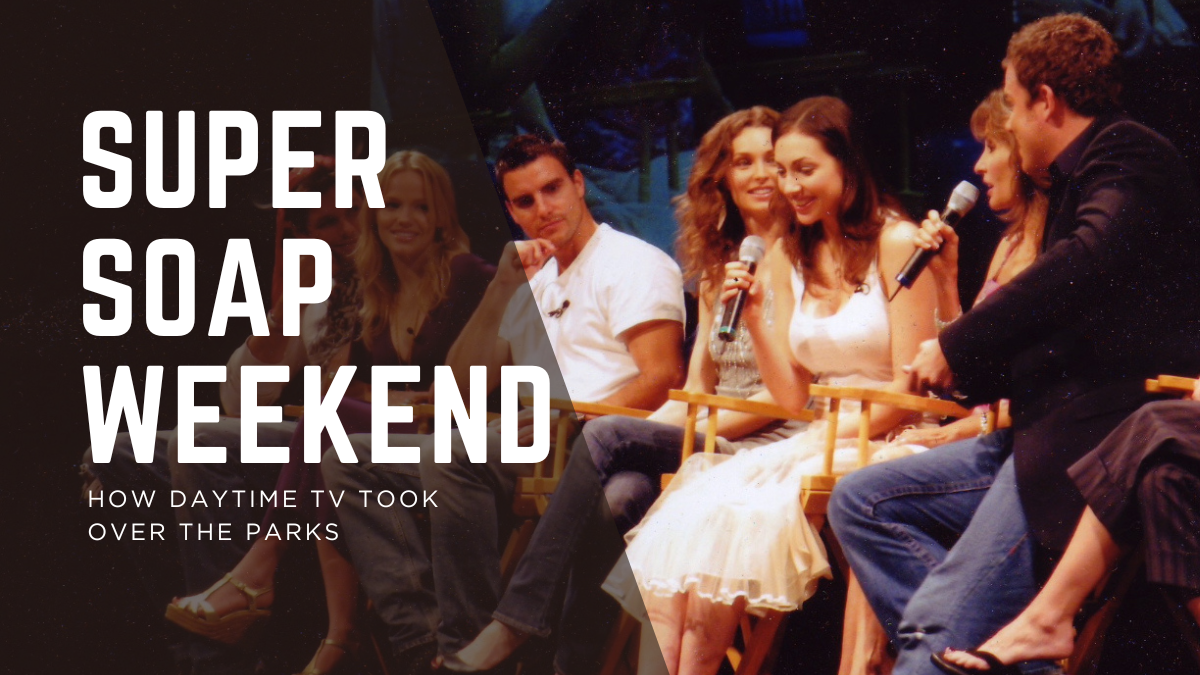
A long time ago in a galaxy that … Well, to be honest, wasn’t all that far away. This was down in Florida after all. But if you traveled to the WDW Resort, you could then experience “Star Wars Weekends.” Which ran seasonally at Disney’s Hollywood Studios Disney World from 1997 to 2015.
Mind you, what most folks don’t remember is the annual event that effectively plowed the road for “Star Wars Weekends.” Which was “Super Soap Weekend.” That seasonal offering — which allowed ABC soap fans to get up-close with their favorite performers from “All My Children,” “General Hospital,” “One Life to Live” and “Port Charles” — debuted at that same theme park the year previous (1996).
So how did this weekend-long celebration of daytime drama (which drew tens of thousands of people to Orlando every Fall for 15 years straight) come to be?
Michael Eisner’s Daytime TV Origins and a Theme Park Vision
Super Soap Weekend was the brainchild of then-Disney CEO Michael Eisner. His career in media began with short stints at NBC and CBS, but it truly took off in 1964 when he joined ABC as the assistant to Leonard Goldberg, who was the network’s national programming director at the time.
Eisner quickly advanced through the ranks. By 1971, he had become Vice President of Daytime Programming at ABC. That meant he was on the scene when One Life to Live joined the lineup in July 1968 and when All My Children made its debut in January 1970. Even after being promoted to Senior Vice President of Prime Time Programming in 1976, Eisner stayed close to the daytime division and often recruited standout soap talent for ABC’s primetime shows.
Fast forward nearly two decades to July 31, 1995. The Walt Disney Company announced that it would acquire ABC/Cap Cities in a $19 billion deal. Although the acquisition wasn’t finalized until February 1996, Eisner was already thinking ahead. He wanted to use the stars of All My Children, One Life to Live, and General Hospital to draw people to Disney’s theme parks.
He had seen how individual soap stars were drawing huge mall crowds across America since the late 1970s. Now he wanted to bring dozens of them together for something much bigger.
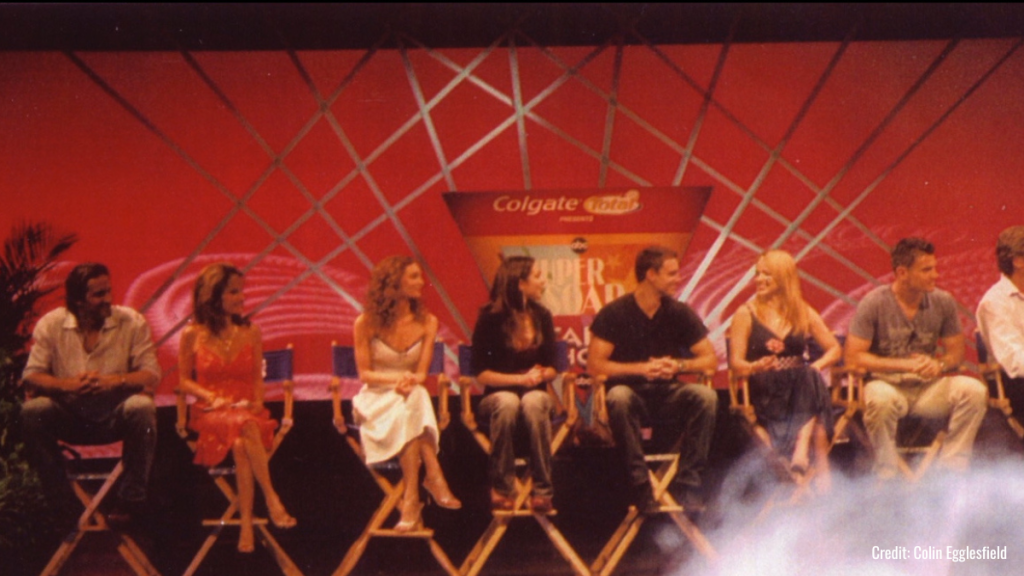
Super Soap Weekend Takes Over Disney-MGM Studios
The very first Super Soap Weekend was announced in June 1996, just a few months after the ABC deal closed. The event was scheduled for October 19 and 20 at Disney-MGM Studios and was a massive success.
The weekend featured panel discussions, autograph sessions, and photo opportunities with the stars of ABC’s daytime dramas. Thousands of fans packed the park for the chance to meet their favorite actors. Due to the overwhelming response, the event became an annual tradition and was eventually moved to Veterans Day weekend each November to better accommodate attendees.
Longtime fans like Nancy Stadler, her mom Mary, and their close friend Angela Ragno returned year after year, making the event a personal tradition and building lifelong memories.
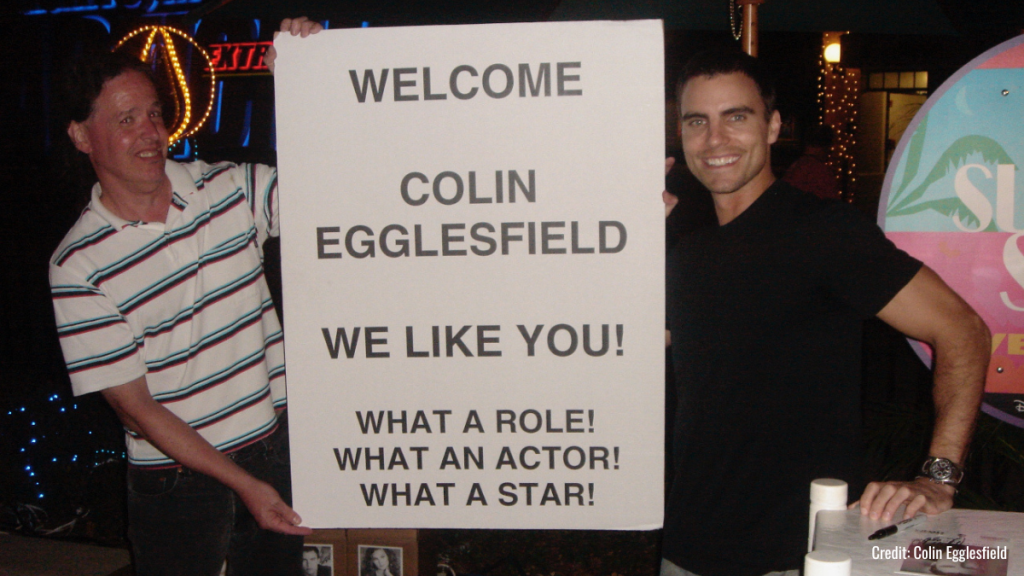


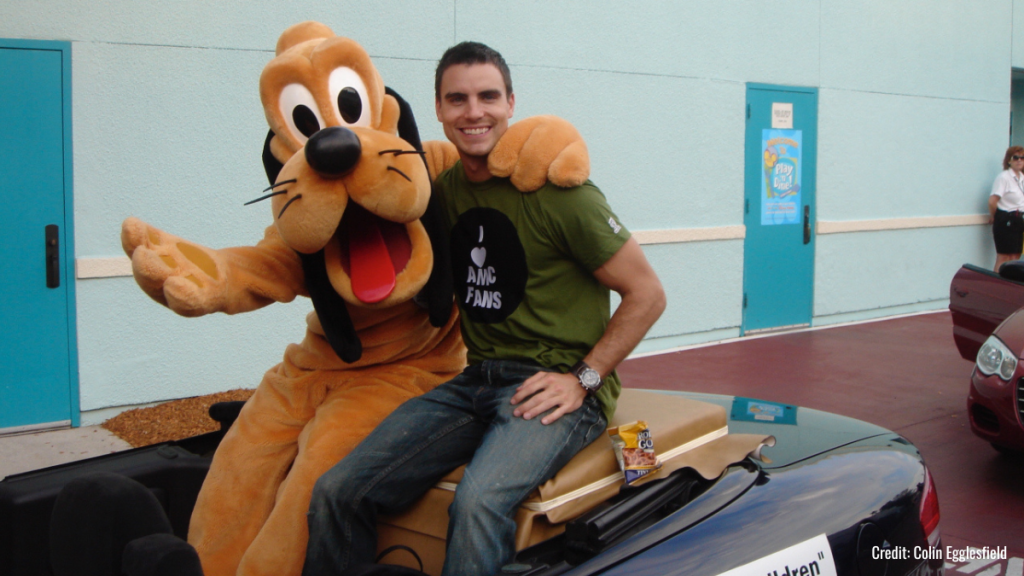
West Coast Events and the ABC Soap Opera Bistro
Disney even tried to recreate the event out west. Two Super Soap Weekends were held at Disneyland Resort, one in April 2002 and another in June 2003.
At Disney’s California Adventure, Eisner also introduced the ABC Soap Opera Bistro, a themed dining experience that opened in February 2001. Guests could dine inside recreated sets from shows like General Hospital and All My Children, including Kelly’s Diner and the Chandler Mansion. The Bistro closed in November 2002, but for fans, it offered a rare opportunity to step into the world of their favorite soaps.
SOAPnet, Port Charles, and the Expansion of Daytime TV at Disney
Eisner’s enthusiasm for soaps extended beyond the parks. In January 2000, he launched SOAPnet, a cable channel dedicated to prime time replays of ABC’s daytime dramas.
During his time at Disney, General Hospital also received a spin-off series titled Port Charles, which aired from June 1997 to October 2003. The show leaned into supernatural plotlines and was another example of Eisner’s commitment to evolving and expanding the soap genre.
The Final Curtain for Super Soap Weekend
In September 2005, Eisner stepped down after 21 years as head of The Walt Disney Company. Bob Iger, who had previously served as President of ABC and Chief Operating Officer of ABC/Cap Cities, took over as CEO. While Iger had deep ABC credentials, he didn’t share Eisner’s passion for daytime television.
In the fall of 2008, Disney hosted the final Super Soap Weekend at what was then still called Disney-MGM Studios. That same year, the park was rebranded as Disney’s Hollywood Studios, and Disney began shifting away from television-focused experiences.
Within the next five years, the rest of Eisner’s soap legacy faded. One Life to Live was canceled in January 2012. SOAPnet was rebranded as Disney Junior in February 2013. Later that year, All My Children ended its 41-year run on ABC.
Only General Hospital remains on the network today, the last standing soap from the golden age of ABC Daytime.
A New Chapter for Daytime TV and Super Soap Fans
The soap genre may have faded from its former glory, but it’s not gone. On February 24, 2025, CBS premiered a brand-new daytime drama called Beyond the Gates, marking the first new soap launch in years.
Meanwhile, All My Children alum Kelly Ripa has been actively working on a revival. In September 2024, she mentioned a holiday-themed movie set in Pine Valley that would bring back many original cast members. The project was in development for Lifetime, though its current status is unclear.
And what about Super Soap? Fans like Nancy and Angela still hope Disney will bring it back. Even if it only featured the cast of General Hospital, it would be a welcome return for longtime viewers who miss that one weekend a year where the magic of Disney collided with the drama of daytime TV.
If you want to hear firsthand what it was like to be part of Super Soap Weekend, be sure to listen to our I Want That Too podcast interview with actor Colin Egglesfield. He shares behind-the-scenes memories from his days as Josh Madden on All My Children and what it meant to be part of one of the most unique fan events in Disney park history.
History
The Super Bowl & Disney: The Untold Story Behind ‘I’m Going to Disneyland!’

One of the highlights of the Super Bowl isn’t just the game itself—it’s the moment when the winning quarterback turns to the camera and exclaims, “I’m going to Disney World!” This now-iconic phrase has been a staple of post-game celebrations for decades. But where did this tradition begin? Surprisingly, it didn’t originate in a stadium but at a dinner table in 1987, in a conversation involving Michael Eisner, George Lucas, and aviation pioneers Dick Rutan and Jeana Yeager.

The Unlikely Beginning of a Marketing Sensation
To understand the origins of this campaign, we have to go back to December 1986, when the Rutan Voyager became the first aircraft to fly around the world without stopping or refueling. Pilots Dick Rutan and Jeana Yeager completed the nine-day journey on December 23, 1986, flying over 26,000 miles before landing at Edwards Air Force Base. Their historic achievement earned them national recognition, and just days later, President Ronald Reagan awarded them the Presidential Citizen Medal at the White House.
Meanwhile, Disney was gearing up for the grand opening of Star Tours at Disneyland, set for January 12, 1987. Following its usual playbook of associating major theme park attractions with real-world pioneers, Disney’s PR team invited astronauts Gordon Cooper and Deke Slayton to the launch event. But in a twist, they also invited Rutan and Yeager, who were still making headlines.
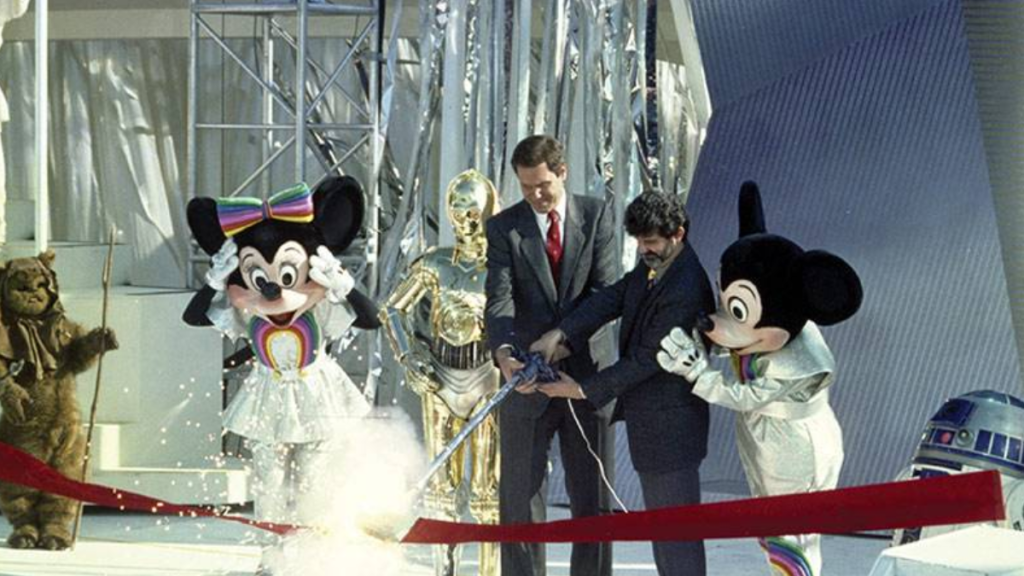
A Dinner Conversation That Changed Advertising Forever
After the Star Tours opening ceremony, a private dinner was held with Disney CEO Michael Eisner, George Lucas, and Eisner’s wife, Jane. During the meal, Eisner asked Rutan and Yeager, “You just made history. You traveled non-stop around the planet on a plane without ever refueling. How are you ever going to top that, career-wise? What are you two gonna do next?”
Without hesitation, Jeana Yeager replied, “Well, after being cramped inside that tiny plane for nine days, I’m just glad to be anywhere else. And even though you folks were nice enough to fly us here, invite us to your party… Well, as soon as we finish eating, I’m gonna go over to the Park and ride some rides. I’m going to Disneyland.”
Jane Eisner immediately recognized the power of Yeager’s statement. On the car ride home, she turned to Michael and said, “That’s a great slogan. I think you should use that to promote the theme parks.” Like many husbands, Michael initially dismissed the idea, but Jane persisted. Eventually, Eisner relented and pitched it to his team.
The Super Bowl Connection
With Super Bowl XXI just around the corner, Disney’s PR team saw an opportunity. The game was set for January 25, 1987, at the Rose Bowl in Pasadena—just miles from Disney Studios. What if they convinced the winning quarterback to say, “I’m going to Disneyland” live on-air?
Disney quickly struck a deal with both quarterbacks—Phil Simms of the New York Giants and John Elway of the Denver Broncos—offering each $75,000 to deliver the line if their team won. Simms led the Giants to victory, making history as the first athlete to say, “I’m going to Disney World!” on national television.
A Marketing Triumph
That year’s Super Bowl had the second-highest viewership in television history, with 87 million people watching Simms say the famous line. The next day, Disney turned the clip into a national commercial, cementing the phrase as a marketing goldmine.
Since then, “I’m going to Disneyland” (or Disney World, depending on the commercial) has been a staple of championship celebrations, spanning the NFL, NBA, and even the Olympics. What started as a casual remark at dinner became one of the most successful advertising campaigns in history.
A Lasting Legacy
Jane Eisner’s keen instinct and Disney’s ability to act quickly on a great idea created a tradition that continues to captivate audiences. The “I’m going to Disneyland” campaign remains a testament to the power of spontaneous inspiration and smart marketing, proving that sometimes, the best ideas come from the most unexpected places.
To learn more about Disney’s ties to the world of sports, check out I Want That Too: A Disney History and Consumer Product Podcast.
Television & Shows
How the Creators of South Park Tricked A-List Celebrities to Roast Universal – “Your Studio & You”
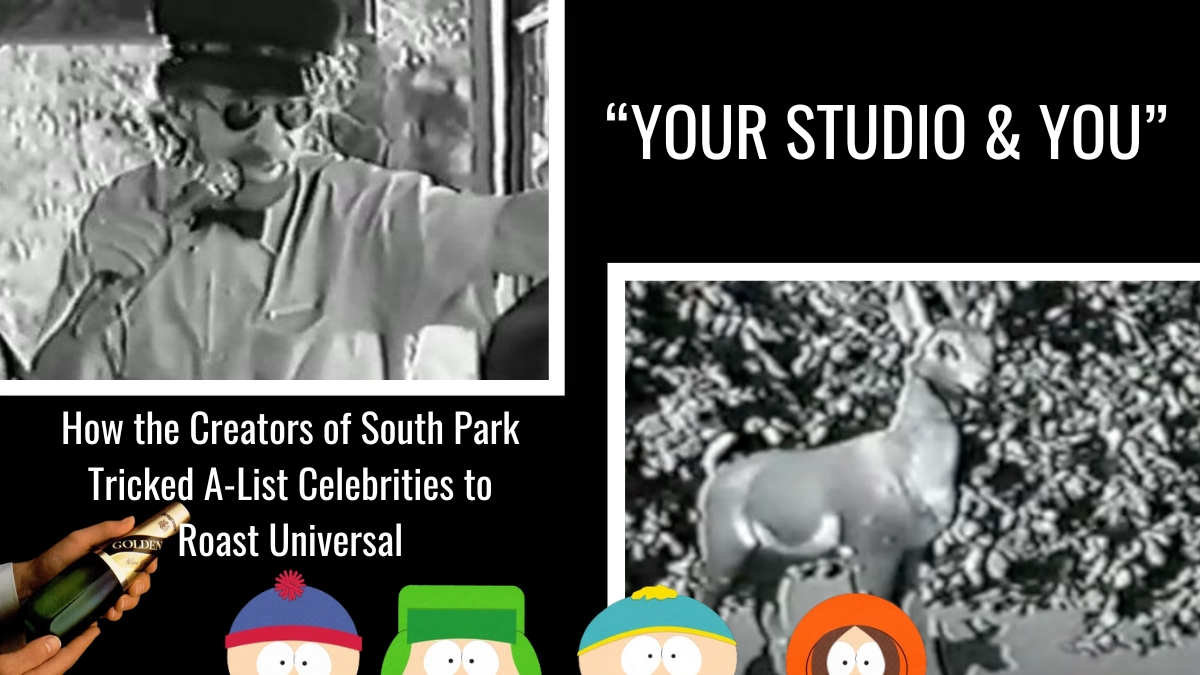
Universal Studios has a rich and storied history, but few moments are as peculiar—and as hilariously cutting—as the creation of Your Studio & You. This 14-minute parody film, commissioned in 1995 to celebrate Universal’s new ownership under Seagram’s, brings together an all-star cast, biting humor, and the unmistakable comedic fingerprints of Matt Stone and Trey Parker.
Long before South Park debuted on Comedy Central in 1997, Stone and Parker were already carving out a reputation for their irreverent style, and Your Studio & You perfectly encapsulates their knack for turning even the most corporate project into something delightfully subversive.
Matt Stone & Trey Parker Before South Park
Stone & Parker were already known out in Hollywood as funny guys. Thanks largely to “The Spirit of Christmas,” which was this video greeting card that they’d crafted for a Fox executive – who then distributed this infamously funny thing (which had Our Lord Jesus Christ & Santa Claus literally duking it out for the holiday affections of Cartman, Kenny, Stan & Kyle) to friends & family.
This was the early 1990s. No internet. Each copy of “The Spirit of Christmas” was made on VHS tape and then mailed. Went viral the old-fashioned way. It’s rumored that George Clooney made over 300 copies of “The Spirit of Christmas” and passed these VHS taps along to friends and family.
Things didn’t move as fast as they do today. “The Spirit of Christmas” still became a sensation out West.
Zucker Brothers
Matt & Trey also had other supporters in the entertainment industry. Among them David Zucker, who was one of the members of ZAZ (i.e., Zucker Abrahams Zucker), the talented trio that made “Airplane!” in 1980, “Top Secret!” in 1984 and the three “Naked Gun” movies.
- The original “Naked Gun” in 1988
- “Naked Gun 2 & 1/2 : The Smell of Fear” in 1991
- and “Naked Gun 33 & a 1/3: The Final Insult” in 1994
All five of these parody films had been made for Paramount Pictures. But in the Late Winter / Early Spring of 1995, Universal had persuaded the Zucker Brothers to come over and set up shop in a bungalow on their lower lot. With the hope that – at some point further on down the line – David & his brother Jerry would start making funny films for Universal.

And it’s during this same window of time (We’re now talking April of 1995) that news breaks that Seagrams (Yep, the adult beverage company. Who – at the time – was making an absolute fortune on the sales of wine coolers) was about to buy a majority stake in MCAUniversal. We’re talking control of 80% of that company’s stock. Which would effectively make Seagrams the new owners of Universal Studios.
Edgar Bronfman
And Edgar Bronfman – the owner of Seagrams – knew that Universal had had a tough time with its previous owners – which had been the Matsushita Electric Industrial Co. of Japan. Matsushita had bought MCA back in November of 1990 for $7.5 billion but had never really understood the entertainment industry.
This is why – after repeatedly butting heads with Lew Wasserman & Sidney Sheinberg (i.e., the heads of Universal Studios & the Universal theme park respectively) when it came to creative control of this company – Matsushita decided to wash it hands of the entire enterprise. Agreeing to sell their holdings in MCA to Seagrams for $5.7 billion (effectively taking a nearly $2 billion loss on this investment).
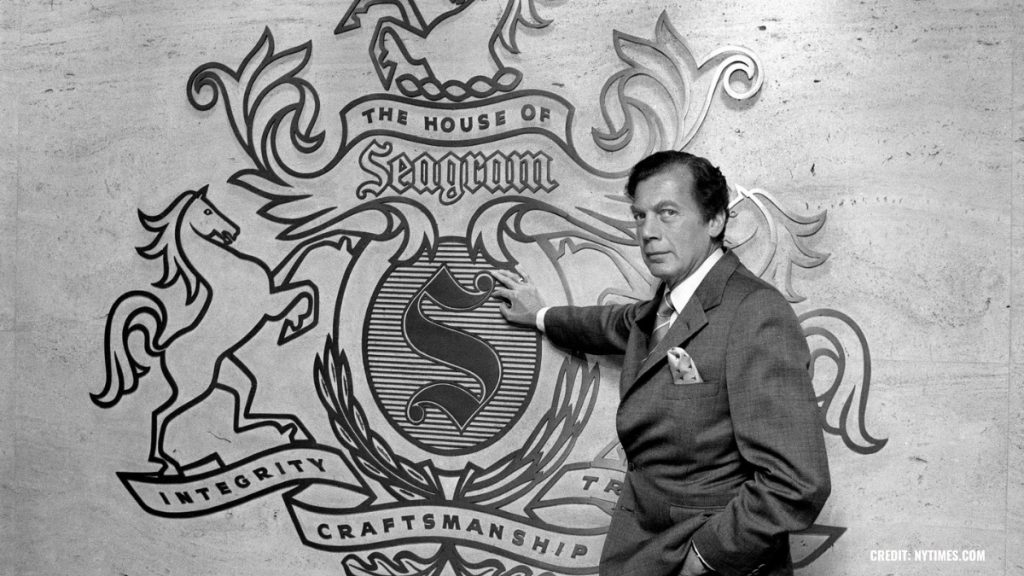
And Bronfman … He knew that some bad feeling had developed between Hollywood’s creative community and the Japanese owners of Universal. The thinking was that executives at Matsushita Electric had just not gotten what it took to make movies & TV shows.
And Edgar? Right from the get-go, he wanted to show that Seagrams was NOT going to be Matsushita Electric Redux. Bronfman was looking for a way to send a clear message to Hollywood’s creative community that Universal’s new owners got it. That they were willing to work with Hollywood to make the best possible movies & TV shows at Universal.
And how did Edgar decide to get this message across? By making a funny movie.
Zucker Commissions Trey Parker for “Your Studio & You”
Mind you, Bronfman himself didn’t make this film. The owner of Seagrams reached out to David Zucker. Who – after initially agreeing to produce this introduction-to-Universal film – then farmed out the production of the actual project to Trey Parker. Who – just two days before shooting was supposed to star on the Universal Lot – persuaded Matt Stone to come help him on this project.
Which brings us to “Your Studio and You.” Which is a parody of an educational film from the 1950s, right down to being shot in black & white and featuring a very generic soundtrack.
Now what’s amazing about watching “Your Studio and You” today is that this 14-minute-long film features some of the biggest names working in Hollywood back in the mid-1990s. We’re talking about people like recent Golden Globe winner Demi Moore, Sylvester Stallone, Michael J. Fox and Angela Lansbury. Not to mention two of the most powerful men in all of Hollywood, Steven Spielberg & Jeffrey Katzenberg.
And what’s especially interesting about watch “Your Studio and You” is that – as you watch these performers go through their paces in this motion pictures (which – most of the time – involves doing some innocuous task while holding a Seagram’s wine cooler) – you often get the feeling that this star is not in on the gag.
So how did Matt & Trey get away with this? Simple. There was never actually a script for “Your Studio and You.”
Filming “Your Studio & You” at Universal Studios Hollywood
Mind you, David Zucker would always insist that there was. Especially when he’d phone up celebrities on the Universal Lot and say “Hey, I’m sending over a couple of college kids later today. They’re working with me on a new parody film. It’s something that we’re doing for the new owners of Universal. I need just a half hour of your time. We’re shooting something special for the party we’ll be holding when the Seagrams people first arrive at the Studio. Absolutely. You’ll definitely get an invite to that party. So can I count on you to help these kids out? Beautiful. They’ll be over there later this morning.”
And then Matt & Trey would show up and say “… Dang, Miss Lansbury. We’re sorry. We must have left our copy of the ‘Your Studio and You’ script back in our office. Which is clear on the other side of the Lot. So – rather than waste your time – why don’t we do this instead? Follow us over to the Psycho House. Where we’re then going to get footage of you painting the front porch on Mother Bates’ house while you say ‘Gosh, with all of the wonderful improvements going on around here, everyone is going to want to work at Universal.’ Oh, and can we also get you to wear this button on the front of your blazer which reads ‘Universal is A-OK’ ? “

And over & over again, the biggest names who were working for Universal at that time took part in the production of “Your Studio & You” because A) David Zucker vouched for Matt Stone & Trey Parker and B) this was something that was being made for the new owners of Universal. And it’s just natural to want to get in good with the new boss.
Steven Spielberg, Jeffery Katzenberg, and Jaws
But no one at Universal anticipated that “Your Studio & You” would wind up being as sharp edged as the finished product turned out to be. I mean, it’s one thing to bite the hand that feeds you. But “Your Studio & You” ? It doesn’t just bite the hand. It takes the hand off at the wrist.
It’s a brutally funny film. With one of the meanest moments reserved for Steven Spielberg, who plays a driver on the Universal Studio Tour who’s trying to persuade a tram full of bored tourists (one of whom is played by Jeffery Katzenberg) that the “Shark Attack” scene down by Jaws Lagoon is actually exciting.
Spielberg actually says lines like “ … Whoa, whoa. What is going on here? Ladies and gentlemen, this never happens. Look out! It’s a shark! Whoa, that is one big scary shark.”
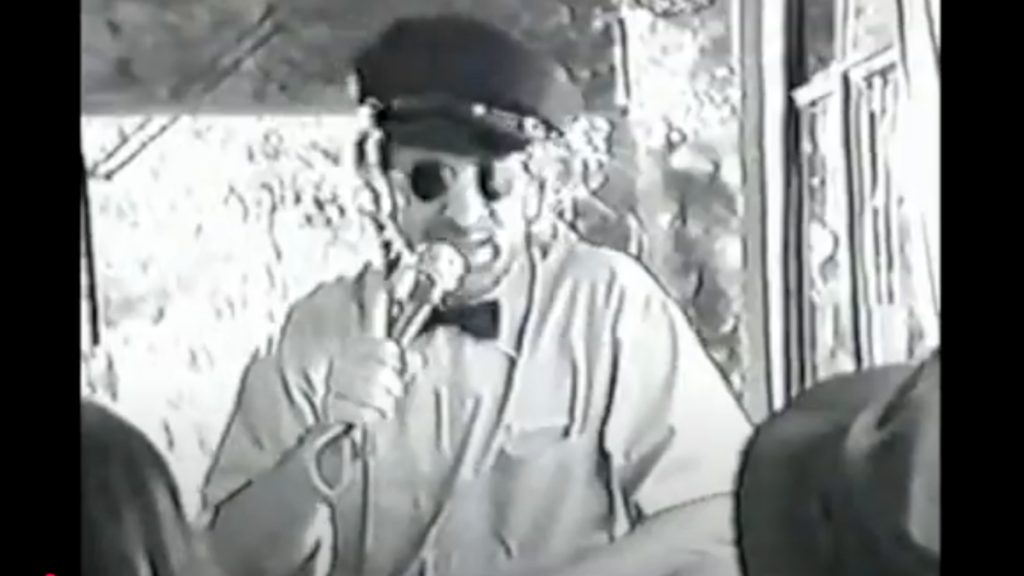
Mind you, as footage of this mechanical shark repeatedly coming up out of the water is shown, “Your Studio & You” ‘s off-screen narrator (who is voiced by Trey Parker says):
“But what about tomorrow? If we don’t keep in step with the times, things that were once neat and thrilling can become old and stupid.”
“Your Studio & You” Reception
This film was supposed to be shown only once at the welcoming party for Seagrams executive on the Universal Lot. And I’m told that – when Edgar Bronfman saw the finished product at that party – he reportedly turned to David Zucker and said “ … That’s a little more mean-spirited that I think it needed to be.”
And with that, “Your Studio & You” was supposed to go back into the Universal vault, never to be seen again. But when “South Park” debuted on Comedy Central in August of 1997 and then became a sensation for its biting humor, there was suddenly a lot of interest in what else Matt & Trey had done. Which is why copies of “The Spirit of Christmas” began to circulate. And – over time – copies of “Your Studio & You” began to bubble up.
Which – as Stone & Parker have repeatedly pointed out – was just not supposed to happen. Largely because none of the celebrities who appeared in “Your Studio & You” had never signed releases for Universal’s legal department. Because – again – this was for a movie that was only going to be shown once at a private function on the Universal Lot.
Matt mentioned (as part of a career retrospective at the Paley Center in LA back in 2000) that “ … they wouldn’t even let us keep a copy of the finished film.”
It’s a funny but brutal movie. And worth taking a look at today especially if you’re a theme park history buff because it shows Universal Studios Hollywood’s “Jurassic Park: The Ride” still under construction on the Lower Lot. That attraction would finally open to the public in June of 1996.
“Your Studio & You” became a lot easier to see after Seagrams sold off its share of Universal to Vivendi in 2000. Copies began propagating online after that. Though Universal Legal will periodically make an effort to get the latest copy of “Your Studio & You” taken off the Internet because – again – none of the performers who appear on camera ever signed the proper releases and/or were paid for their efforts.
That said, if you’re up for a mean-spirited laugh, “Your Studio & You” is well worth 14 minutes of your time. That said, once you watch this thing, be warned:
- You’re immediately going to be thirsty for a Seagram’s wine cooler
- And you’re going to have a sudden desire to go out & buy a porcelain deer.
-

 Theme Parks & Themed Entertainment7 months ago
Theme Parks & Themed Entertainment7 months agoDisney’s Forgotten Halloween Event: The Original Little Monsters on Main Street
-

 Theme Parks & Themed Entertainment8 months ago
Theme Parks & Themed Entertainment8 months agoThe Story of Mickey’s Not-So-Scary Halloween Party: From One Night to a Halloween Family Tradition
-

 Film & Movies8 months ago
Film & Movies8 months agoHow “An American Tail” Led to Disney’s “Hocus Pocus”
-

 Theme Parks & Themed Entertainment6 months ago
Theme Parks & Themed Entertainment6 months agoDisney and Macy’s 90-Year Thanksgiving Day Parade Partnership: From Mickey’s First Balloon to Minnie’s Big Debut
-

 Television & Shows4 months ago
Television & Shows4 months agoHow the Creators of South Park Tricked A-List Celebrities to Roast Universal – “Your Studio & You”
-

 History3 months ago
History3 months agoThe Super Bowl & Disney: The Untold Story Behind ‘I’m Going to Disneyland!’
-

 Podcast4 weeks ago
Podcast4 weeks agoEpic Universal Podcast – Aztec Dancers, Mariachis, Tequila, and Ceremonial Sacrifices?! (Ep. 45)
-

 Television & Shows1 week ago
Television & Shows1 week agoThe Untold Story of Super Soap Weekend at Disney-MGM Studios: How Daytime TV Took Over the Parks






